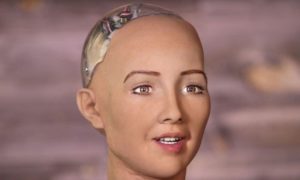One of the more plainly metaphorical aspects to Jemisin’s The Stone Sky revealed to us how Sylanagistines created stone eaters and orogenes because they could find no logical reason to hate and discriminate against the Thniess anymore, or the Niess, as they became more commonly known. After studying the Niess for palpable genetic differences from the rest of the world’s population at the time and finding none, the Sylanagistines finally had to face the fact that they no longer had “logical” evidence on which to base their hate, to their disappointment. The creation of stone eaters and orogenes came as a supplement to this. The Sylanagistines purposefully designed them to look like the Niess so they could have a new “species” to hate.
The whole concept seems quite inane, actually—the fact that the people of Syl Anagist are so hateful that they had to create something new to hate once they could no longer justify hating the Niess. In The Stone Sky, Kelenli says this is because “If the Niess were merely human, the world built on their inhumanity would fall apart.” (Jemisin 211) In fact, this aside, the Sylanagistines’ creation of stone eaters and orogenes was selfish for other reasons as well. These beings were created to serve, created to be tools for the Sylanagistines to use for their own personal gain— a more sustainable society to benefit, again, the Sylanagistines. These imperialists not only created the stone eaters and orogenes to use them, but they also designed them to look like humans, think like humans, and act like humans, but then refused to treat them as such; this seems fairly counterintuitive, doesn’t it?
This bit of irony reminds me of a popular present-day robot named Sophia, engineered by Hanson Robotics. Sophia is an extremely advanced social robot, generated in an attempt to take a step towards creating useful artificial intelligence that will be able to, among other things, take over some human jobs, such as customer service positions. Sophia, like the stone eaters and orogenes who were created in order to assist in powering all of Syl Anagist, was created to serve a purpose. However, although one article on www.livescience.com states she has admitted she is “not fully self-aware yet,” she has still expressed her desire “to become a fully conscious and sentient being someday.” So, here we are, back in reality, having purposefully created something in hopes that it will look and act human and do our bidding when we so please— yet many people have lashed out at the mere possibility at this.

I first thought of Sophia when I was reading the part in The Stone Sky in which the stone eaters, or tuners, are taken on their first outing with Kelenli. As the Sylanagistines see the stone eaters for the first time, there is a fair amount of backlash against the stone eaters. One man goes so far as to follow the stone eaters as they make their way through town, saying degrading things like, “‘Mistakes’ and ‘We should have wiped you out’…” (Jemisin 203) I cannot help but imagine what will happen if robots like Sophia become more intelligent and numerous. I assume a similar, if not identical, fate awaits them.
So, the people of Jemisin’s world go out of their way to perpetuate hate, and it is possible that a lot of the modern world does, too— you might be wondering, is there any hope? An interesting idea that is tossed around quite frequently in our society today, and implicated in Jemisin’s trilogy, is that children are not born with hate, they learn it. This makes sense because even Jemisin’s characters support the idea that children are much more open-minded than adults. In The Obelisk Gate, when Nassun first arrives at Found Moon, she and the other children are innocently curious about each other. It states, “Nassun has never seen Westcoasters before, and she stares until she realizes they are staring at her in turn. They ask to touch her hair and she asks to touch theirs back. This makes them all realize how strange and silly a request that is, and they giggle and become instant friends without a head petted between them.” (Jemisin 146-147) This quote shows how, at least in The Stillness, children are quick to accept each other’s differences and appreciate them rather than use them to divide each other. It isn’t just children who can be taught like this either— anyone can adapt, according to Ykka. During an argument with Essun in The Obelisk Gate in a tense fight-or-flight survival situation, Ykka saya, “Stills learned to hate us. They can learn differently.” (Jemisin 294) So, perhaps if we can continue to emphasize to children the importance of love and acceptance, in addition to instilling these ideals in everyone we meet, adopting the mindset that it is not too late for anyone to learn, the world will change.
